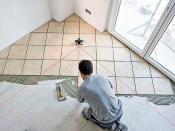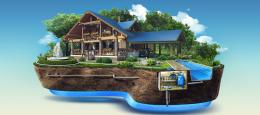Search
Login
Water supply from a well, water supply at a summer cottage from a well, water supply of a private house from a well, do-it-yourself water supply installation, useful tips
Providing a private house or cottage with water is one of the main aspects of a person’s comfortable life. A full-fledged water supply and proper sanitation allow you to solve a number of domestic issues, as well as make it possible to use all the benefits of civilization: a washing machine and dishwasher, various plumbing.
The most common way to supply water is to supply water from a well. Consider the main stages of arranging water supply at home and practical recommendations to ensure the reliability and stability of the water supply system.
Content
- Well on a personal plot of dignity of autonomous water supply
- Autonomous water supply scheme: the main elements of the system
- Arrangement of a water intake system
- Yard line: water supply from the well
- Water distribution in the house video
- Recommendations of specialists for installation and configuration of the water supply system video
Well on a personal plot of dignity of autonomous water supply
For water supply of a private house, various sources of water intake can be used: a centralized water supply system, a well or a well.
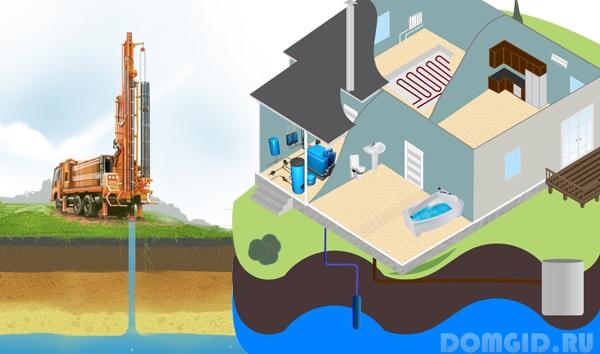
Water supply of a private house from a well has some advantages:
- Autonomy of water supply. The homeowner sets control over the volume of water supply on his own.
- High quality and environmental friendliness of water. A simple and artesian well has sufficient depth, so the water from them does not contain harmful compounds and impurities.
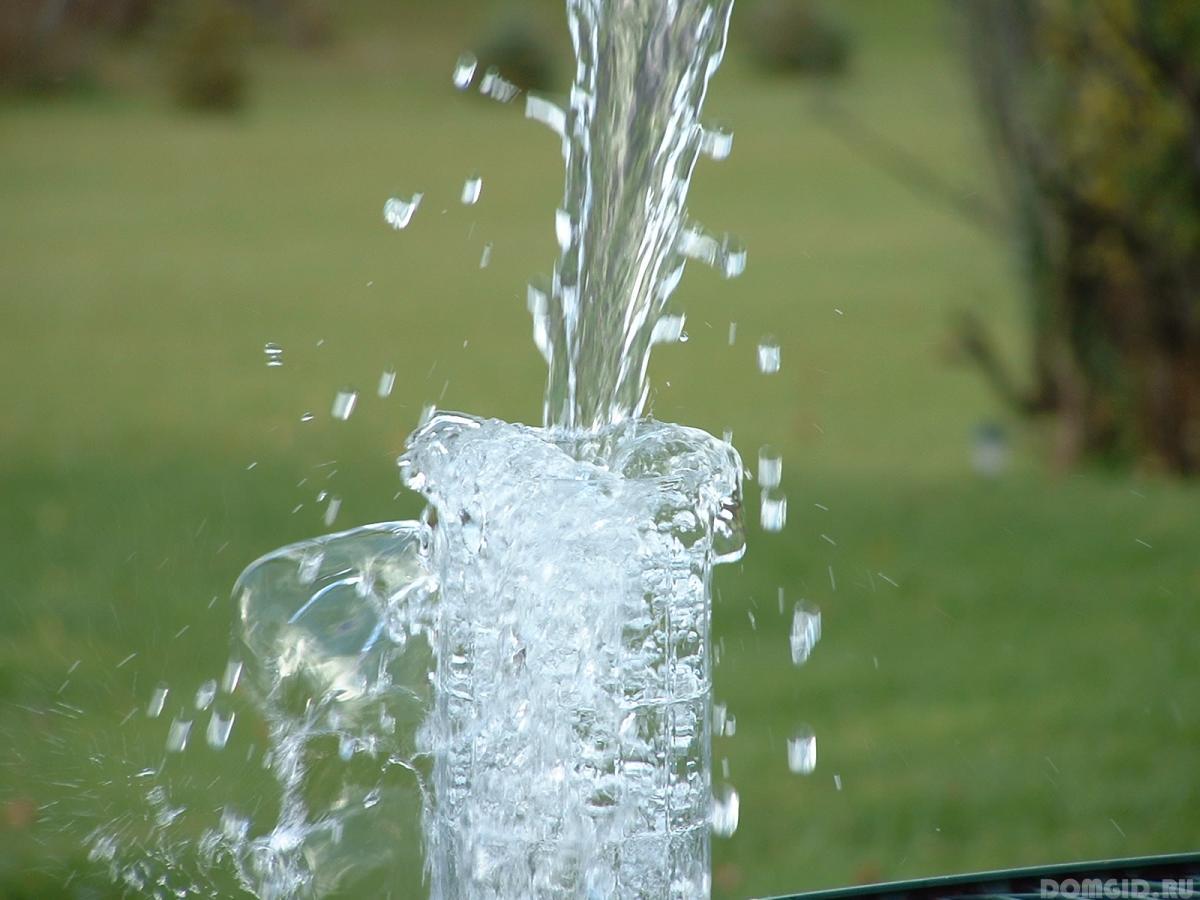
- Economic efficiency. Of course, drilling a well and conducting a water supply to the house is not a cheap pleasure, but over time, these costs pay off, since there are no utility bills for used cubic meters of water.
First of all, it is necessary to determine the type of well: sand or artesian.
The sand well has a depth of 40-50 meters to the upper aquifers of the sand horizon. If you get on the bed of an underground river, then the level of well drilling can be reduced to 15 meters.
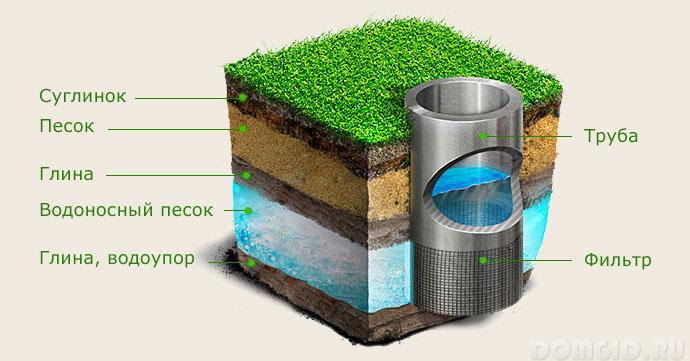
Advantages of a well on sand:
- water quality is better than in a well or centralized line;
- well completion rate (2-3 days);
- you can drill a well without using special equipment.
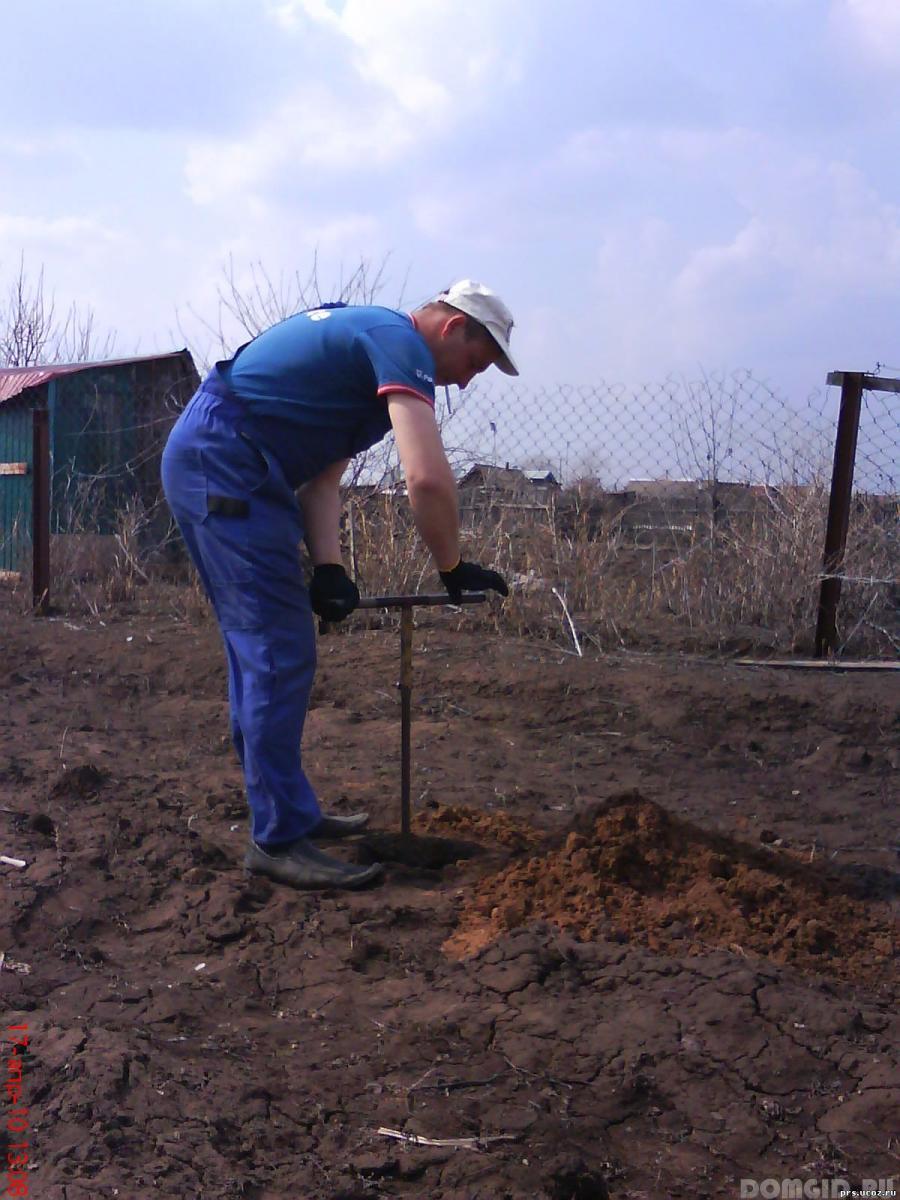
Disadvantages of a sand well:
- low productivity of about 1.5 m3 / hour;
- service life up to 10 years;
- water may contain impurities;
- needs periodic pumping.
A sand well is suitable for seasonal water supply of a summer cottage, for a cottage or a private house it is better to equip an artesian well
The depth of an artesian well can reach 200 meters affects the aquifer of calcareous rocks. The drilling of an artesian well must be coordinated, since the calcareous aquifer is considered a strategic reserve of the state.
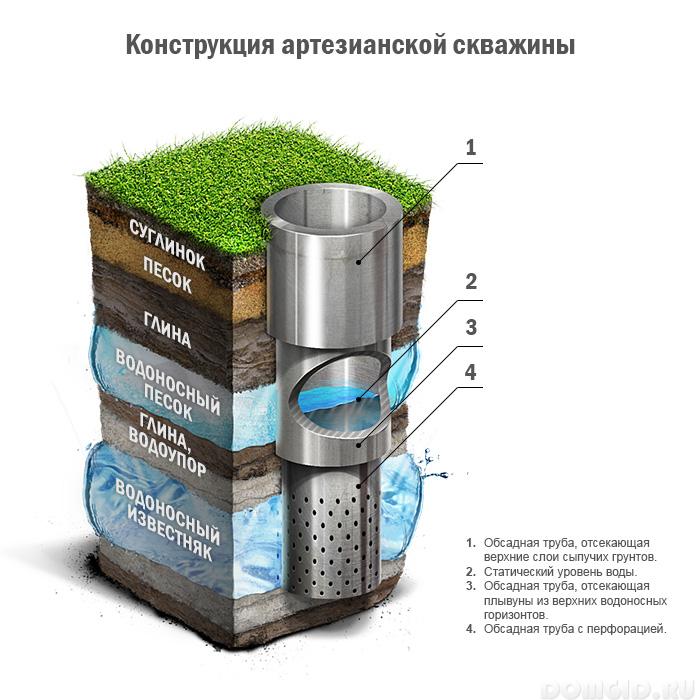
Advantages of an artesian well:
- high productivity of about 10 m3 / hour;
- unlimited supply of lime water;
- life of about 50 years;
- high quality water;
- water is supplied under high pressure.
The disadvantages of the artesian well:
- the need to coordinate the project and obtain permits;
- high cost of well drilling (work must be performed by a specialized company).
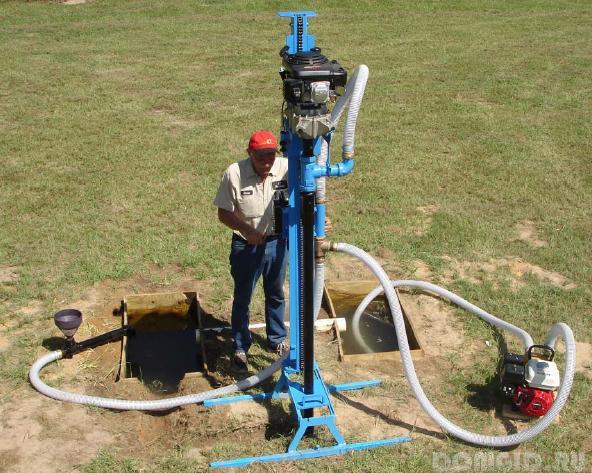
Autonomous water supply scheme: the main elements of the system
Whatever the source of the autonomous water supply of a private house, it is necessary to create a scheme indicating all the basic elements of the system and the materials used for laying the water supply.
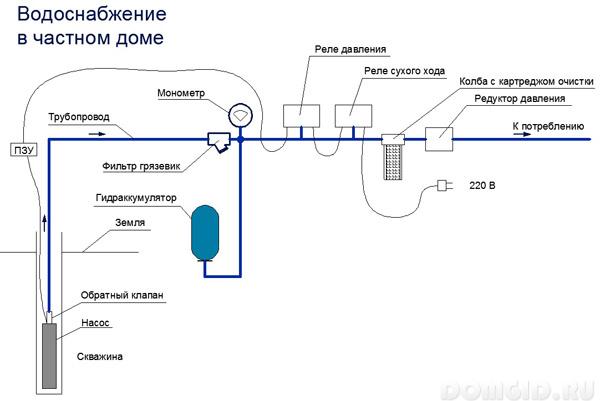
The water supply scheme of a private house includes the following elements.
- Well source of water.
- Caisson auxiliary well room (plastic or metal barrel). Protects the mouth from groundwater, rainfall and ensures normal temperature in the well.
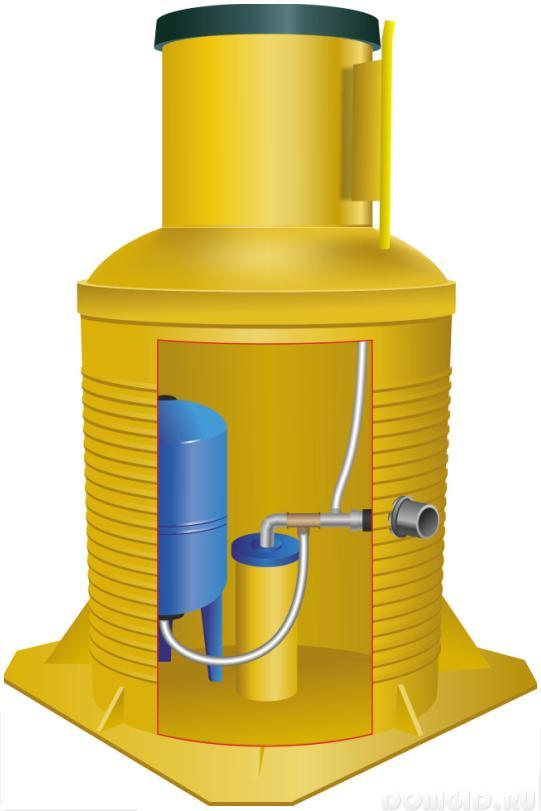
- Autonomous pumping station or deep well pump for water intake from the well.
- The non-return valve prevents the movement of water in the opposite direction.
- A hydraulic accumulator (hydraulic tank) accumulates a certain amount of water and maintains pressure in the system. It is from the hydraulic tank that water flows to the points of water intake.
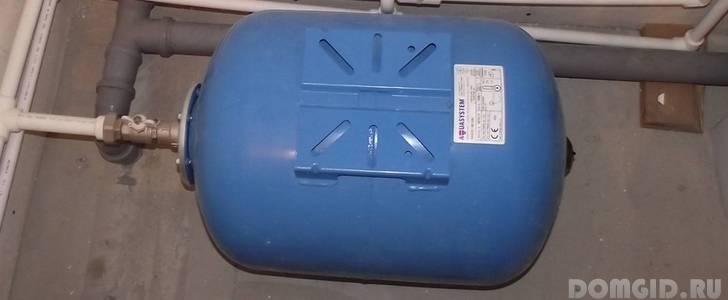
- Water Purification Filters:
- the mud filter does not let large crumbs pass into the accumulator (if the water source is an artesian well, then you can not install such a filter);
- filter with a cleaning cartridge; mechanical cleaning of small admixtures of clay, sand, rust and dirt.
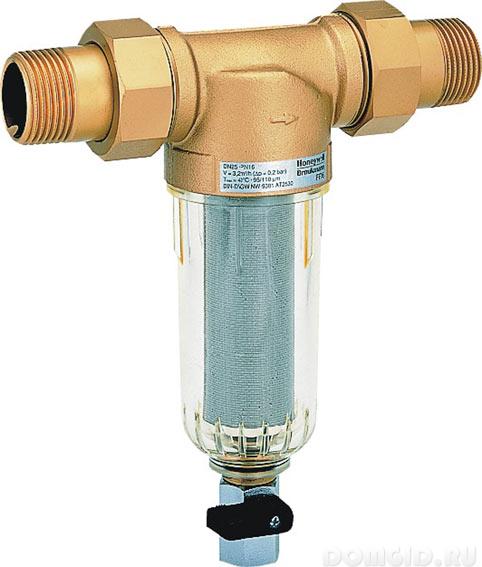
- The pressure gauge is used to control the pressure in the water supply system. Required to set up a pressure switch.
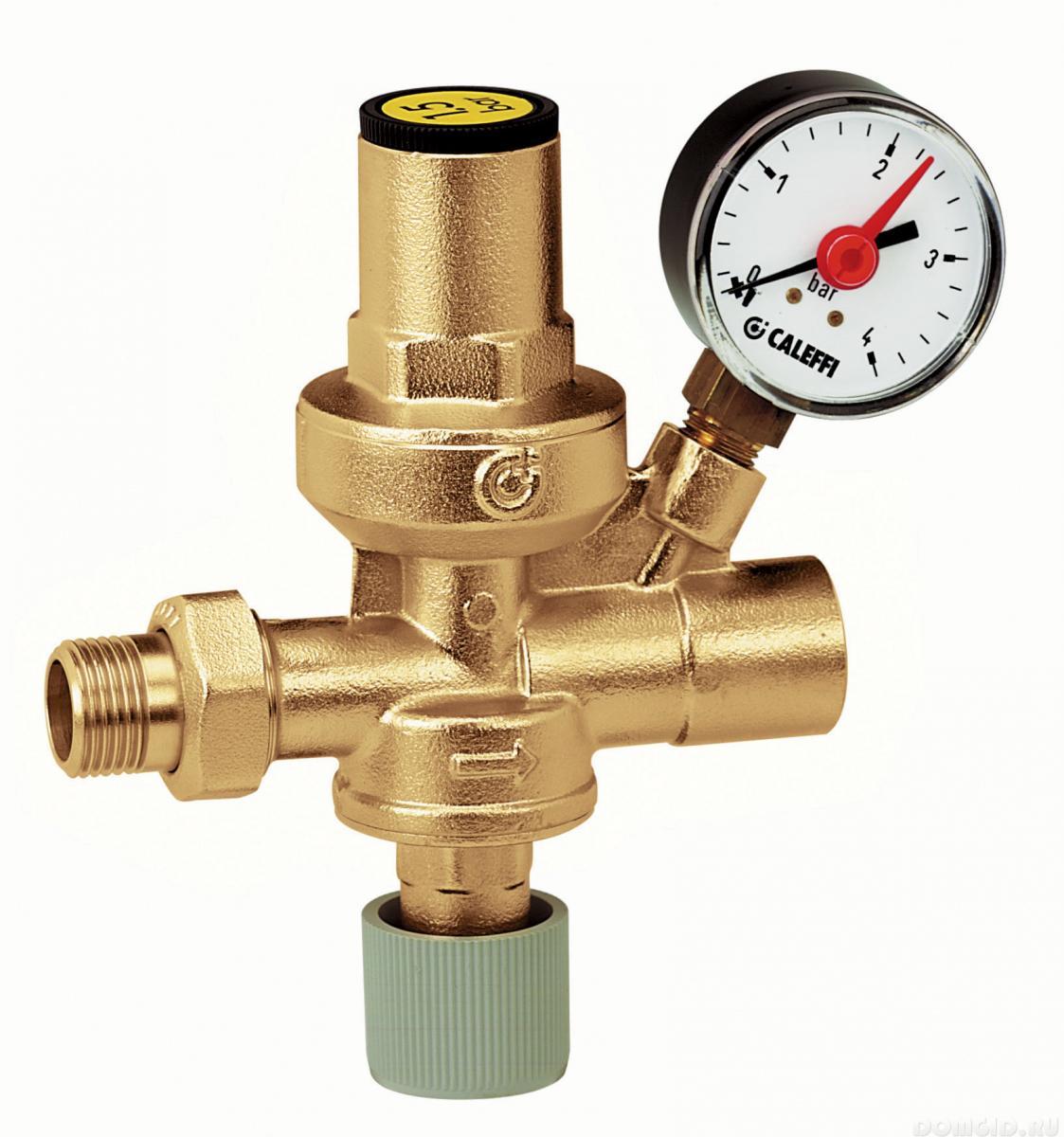
- The pressure switch turns the pump power on and off. The minimum and maximum pressure thresholds are configured in the relay: at low pressure, the relay closes the contacts; the pump switches on; at high pressure, the contacts open.
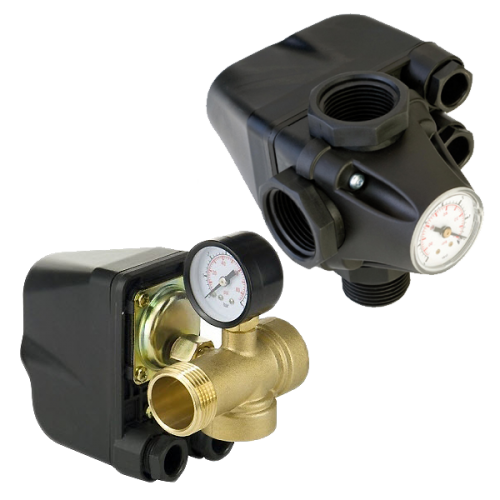
- The dry running relay disconnects the pump from the power supply if the water in the well runs out.
- A pressure reducer is needed so that the water flow at the outlet has a maximum pressure. In essence, it is a pressure stabilizer that smooths the lower and upper pressure thresholds.
- ROM is a start-up device necessary for starting and gradual acceleration to the maximum speed.
The water supply system of a private house can be divided into three blocks:
- Water intake system.
- Yard highway.
- House water supply.
Arrangement of a water intake system
well drilling and installation of a caisson
The process of drilling a well for water sampling soil using a special drill. Depending on the type of well and its depth, drilling can be performed independently, or use the services of drilling rigs. The method of drilling (shock, rotational) will depend on the type of soil.
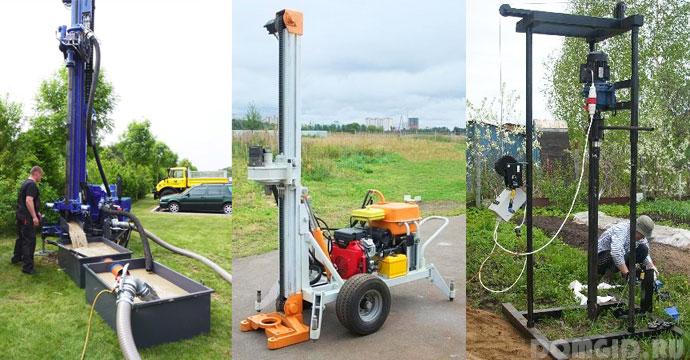
The place around the location of the proposed well should not have any underground paths and buildings. To equip the well, it is necessary to allocate a plot of 4 * 6 m2
For manual drilling use:
- the tripod;
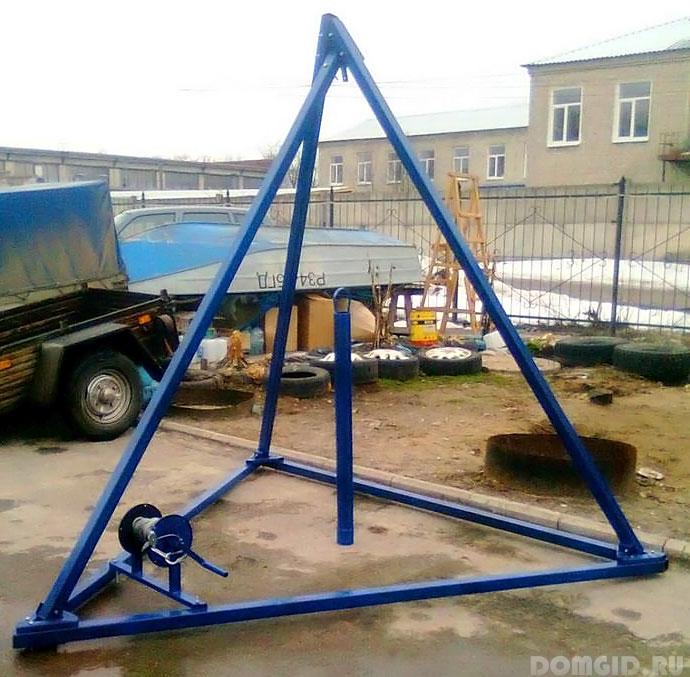
- drill column;
- lift.
Well Drilling Sequence:
- A tripod is installed above the well site.
- To excavate the upper layers of the soil (1-1.5 m), a pin drill must be used.
- After passing through the upper layer, replace the pin with a casing drill.
- Drilling continues until the aquifer is reached.
- After finding the right layer, inside the casing, you must insert a galvanized water pipe with a filter at the end.
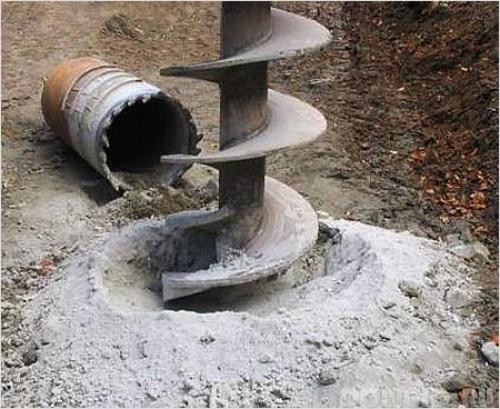
- Connect the pipe sections to each other with couplings, treat the joints with sealant.
- Take out the casing.
The next step in arranging the caisson. This room is necessary for protection against groundwater, freezing and for well maintenance. In the caisson, the pipe exit from the well and the water supply leading to the house will be connected.
You can purchase a ready-made caisson case, or you can make it yourself from concrete rings or bricks.
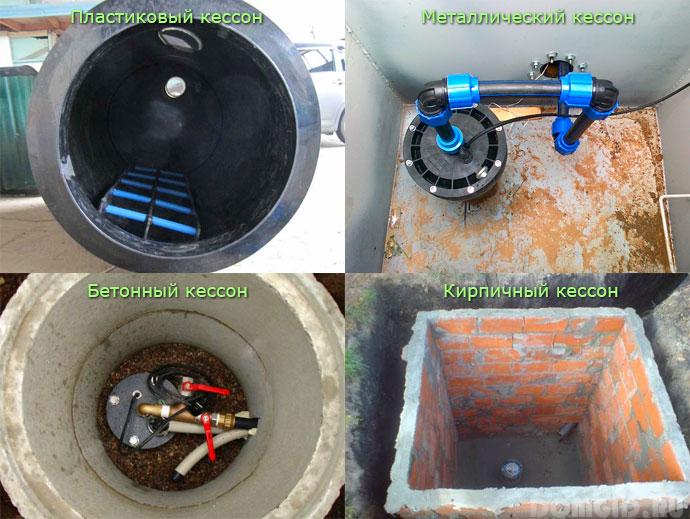
The caisson must be installed so that its bottom and pipeline are below the level of freezing of the soil, and the roof of the hull is 30 cm above the surface
Installation order of the caisson:
- Dig a well pipe to a depth of about 2.5-3 meters. The diameter of the pit should be twice the size of the caisson.
- At the bottom pour a concrete pad (20 cm thick).
- Install the caisson.
- To cut the pipe of the well, it should protrude inside the caisson by 50 cm.
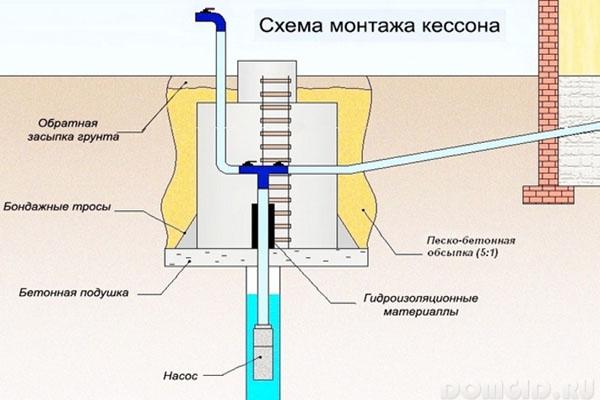
- At the same level (2 m), you need to dig a trench to the house for laying the water pipe.
- The outer walls of the caisson must be waterproofed: coated with bituminous mastic, glued roll waterproofing.
- Insulate the walls of the caisson from the inside.
- Along the contour, pour the caisson with concrete mortar (thickness 30-40 cm), not reaching the surface of the earth by 50 cm.
- After the concrete has hardened, fill the remaining space with a mixture of dry concrete and sand. Sprinkle with soil on top.
optimal pump selection
To ensure the supply of water to consumers with the necessary pressure, you need to install powerful equipment for lifting water. It can be an automated pumping station for water supply of a private house or a deep pump.
Pump station includes:
- water pump;
- accumulator;
- pressure switch.
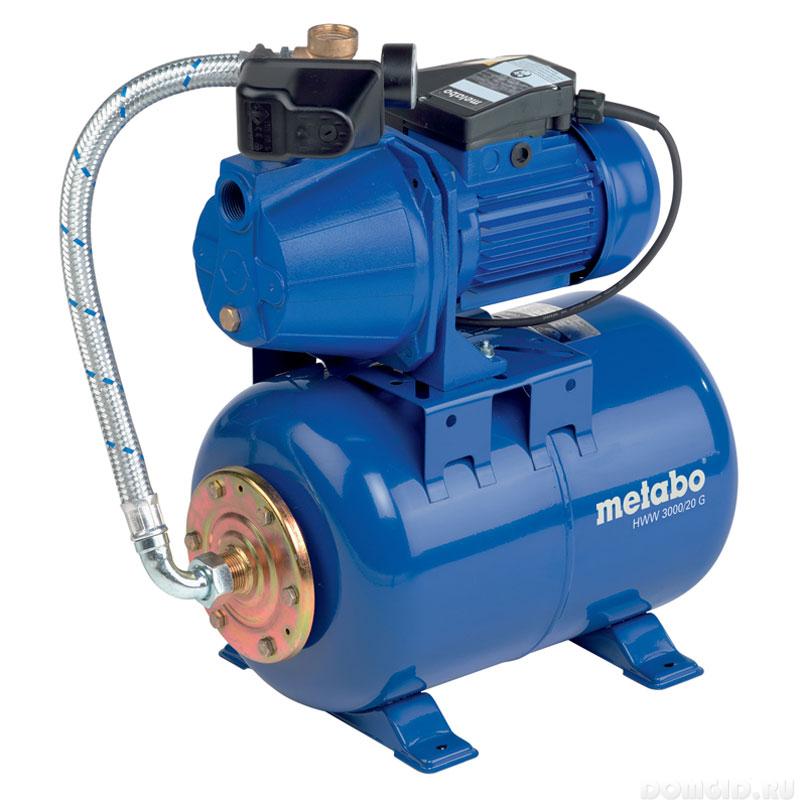
The pump station is suitable for servicing a shallow well (up to 10 m) if the distance from the water intake point to the final consumer is not more than 10 meters
An autonomous station can be used to equip a water supply system at a summer cottage from a well, and to provide water to a cottage or a private house, it is better to install a deep well borehole submersible pump.
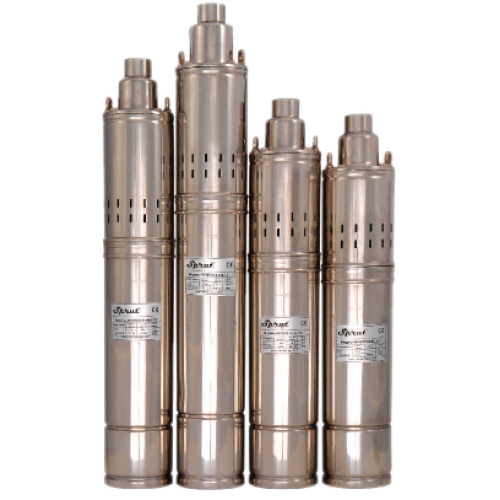
When choosing a submersible pump model, consider:
- pump head pressure force applied to push water through;
- flow rate (productivity) of the pump.
It is necessary to determine the required power of the submersible pump to service a particular well. Consider the example of a private 2-storey house for a family of 4 people. Summarize the following indicators:
- well depth (35 m);
- the distance from the accumulator to the well outlet in a ratio of 1:10 (0.8);
- distance from ground level to the highest water intake point (about 3.5 m for a 2-storey building);
- required pressure at a high water intake point (3);
- possible losses in the system (about 2).
Thus: Pump head \u003d 35 + 0.8 + 2 + 3 + 2 \u003d 44.3 m
Peak water consumption by the family of 38 l / min (2.28 m3 / h) determines the pump capacity.
installation of a submersible pump
Lower the pump into the well very carefully so as not to damage the equipment. To do this, you can use a winch for drilling wells or cables.
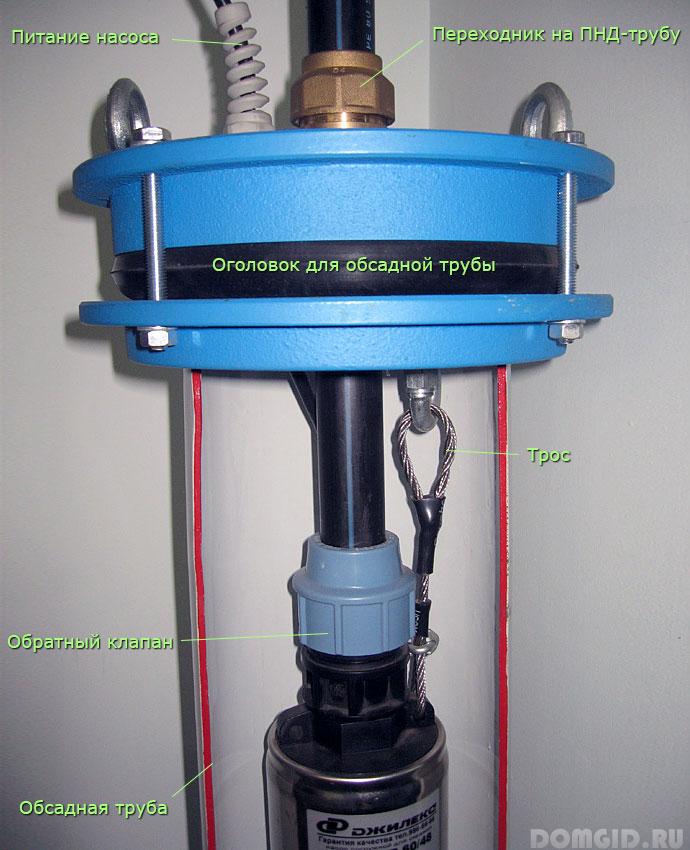
Pump immersion sequence:
- Connect the non-return valve to the pump.
- Attach the crimp sleeve and connect to the outer pipe.
- Pass the cable through the fixing eyes and fix it with metal clamps.
- Attach the power cable and pipe to the cable.
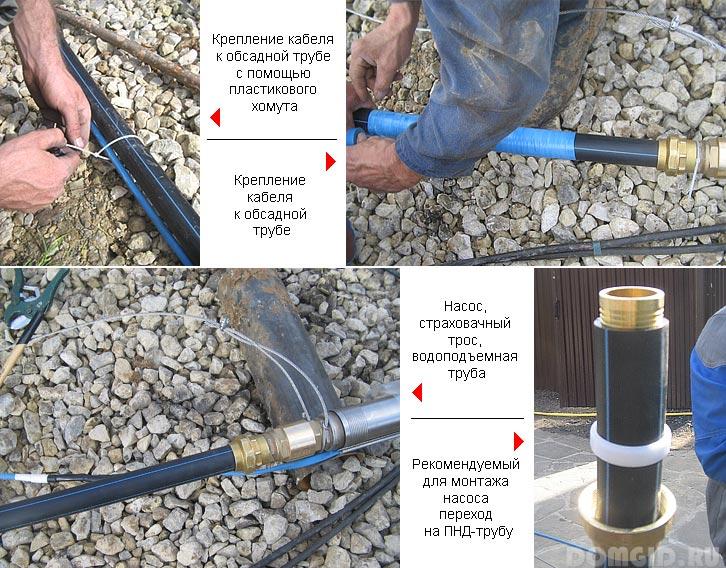
- Lower the pump to the bottom of the well and make a mark on the cable.
- Raise the pump up 1 meter.
- After diving to the desired depth, it is necessary to fix the cable in the head, which is worn on the casing.
- After 5-10 minutes, the pump will be filled with water and you can check its operation.
The next step after installing the pump is bringing the pipeline into the house and assembling an automatic water supply system.
Yard line: water supply from the well
tools and materials
To carry out water supply on the site, you can use different types of pipes:
- Copper pipes are the most expensive, but also the most reliable pipes. The material is not susceptible to corrosion, exposure to aggressive biological environment and ultraviolet radiation, has good heat transfer.

- Plastic pipes aluminum pipes, coated on the outside and inside with polyethylene. Such pipes are sensitive to freezing of the soil, but resistant to corrosion and solar radiation. Bending the pipe at an angle of 90 or more is possible only with the use of fittings.
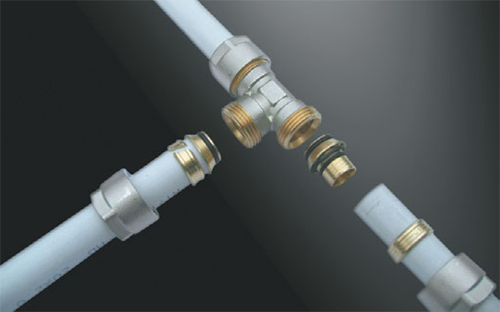
- Iron pipes are reliable and durable, but they lend themselves to corrosion.
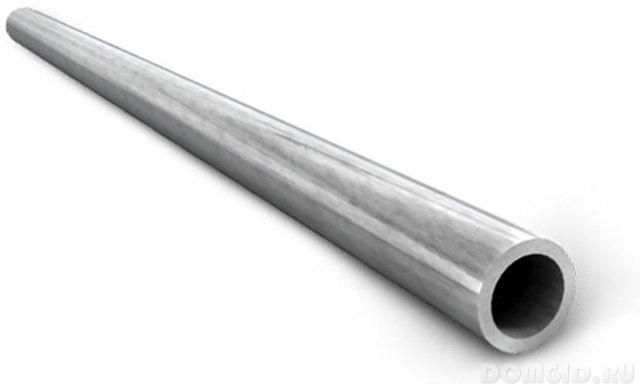
- Polypropylene pipes are often used in the installation of water pipes with their own hands. The material has good performance characteristics: it does not oxidize, is easy to install, reliable and durable (service life of about 50 years).
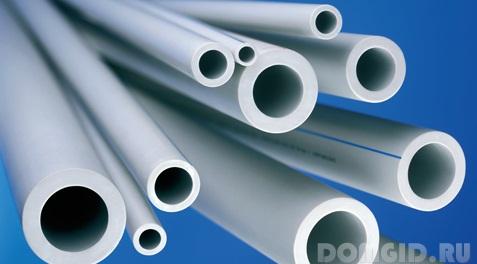
The diameter of the pipeline from the well should be 32 mm
Tools for carrying out the pipeline:
- For mounting steel or copper water pipes:
- adjustable, gas and wrenches;
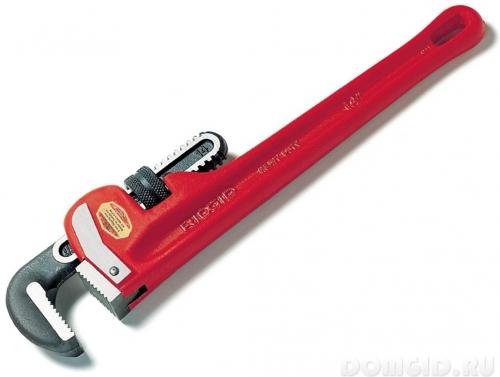
- plugs, couplings, adapters, drives.
- adjustable, gas and wrenches;
- For the installation of plumbing from metal-plastic pipes:
- adjustable, gas and wrenches;
- fittings, fum tape.
- For the installation of polypropylene pipes, a soldering iron with nozzles is required.
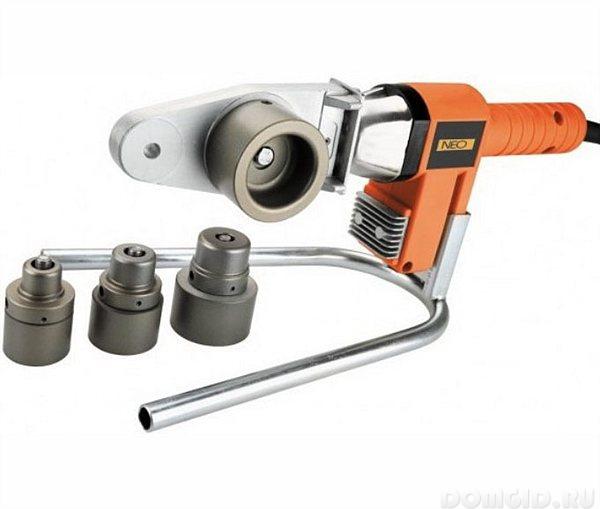
sequence of laying and warming water supply
The pipeline can be laid in two ways:
- through the trench;
- on top of the earth.
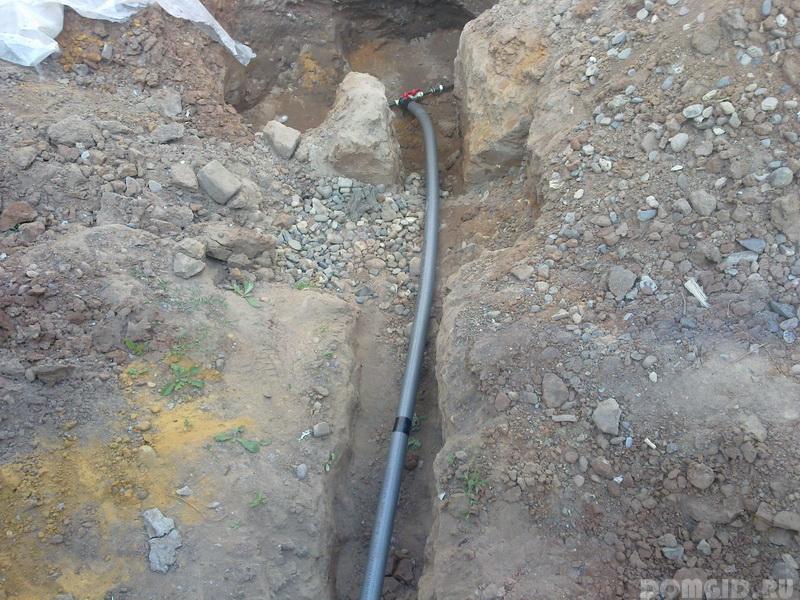
In the first case, a trench is excavated at a depth of 2 meters and a pipeline is laid. The pipe in the places of lifting must be insulated (especially near the foundation). This can be done using a self-regulating heating cable.
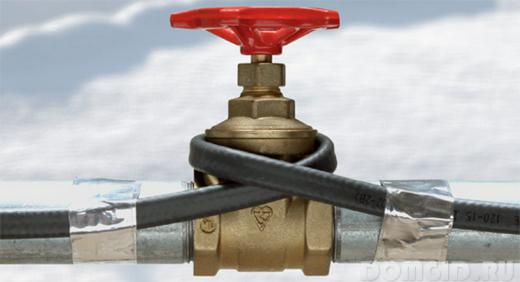
The foundation of the house to which the water supply is connected must be insulated, at least to a depth of 1 meter
If the water supply is laid on top, then a heating cable (9 W / meter) must be brought to the pipe. In addition, the whole pipe is thoroughly insulated with heat-insulating material, a layer of insulation of at least 10 cm.
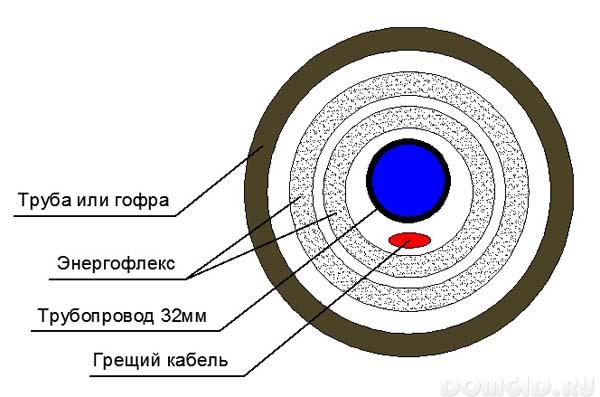
You can use energy flex and cotton. The joints between the insulation must be wrapped with reinforced tape, this will improve the sealing between the layers.
The pipe must be insulated along the entire length of the yard line: from the house to the well
The entire water supply cake is placed in a large corrugated or sewer pipe. Such measures will avoid freezing the water supply and use the well in winter.
Together with the pipe, the power cable for the pump can also be laid at the same time. It is better to use a 4-core cable with a cross section of 2.5.
After installing the pump and laying the water supply to the house, it is necessary to assemble an automatic water supply system according to the scheme.
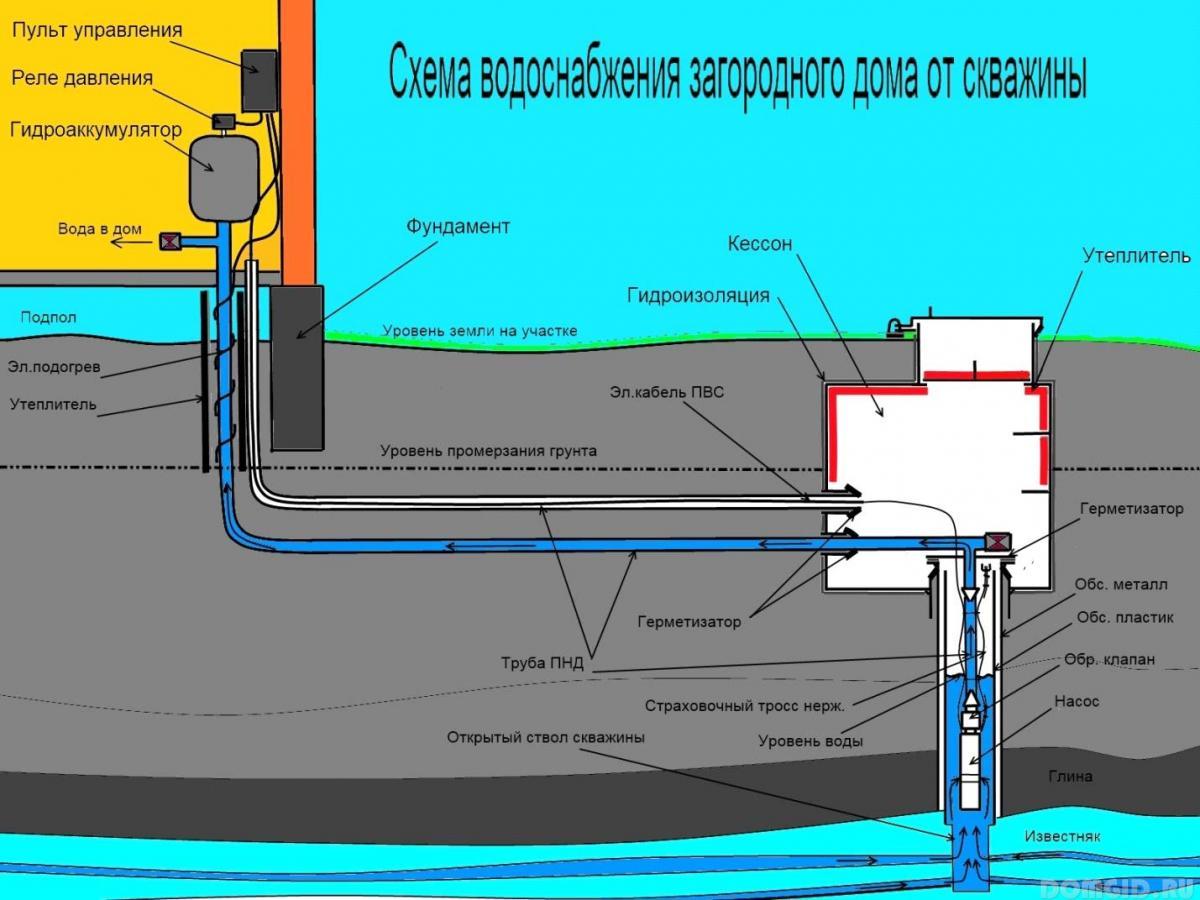
Water distribution in the house
Laying water pipes in a private house can be performed according to two schemes:
- Serial connection of consumers. This option is suitable for small houses, in which no more than 2 people live. With a large number of tenants, inconvenience may arise: the pressure in the system drops sharply with the simultaneous inclusion of several water intake points.
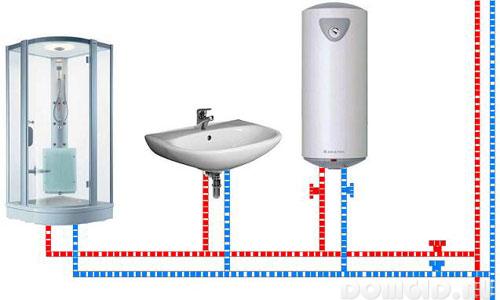
- Collector connection of consumers to the system is a more complex scheme of water supply arrangement, but more convenient in operation. Pressure problems do not arise. Pipe wiring in cottages and large private houses is carried out according to the collector scheme.
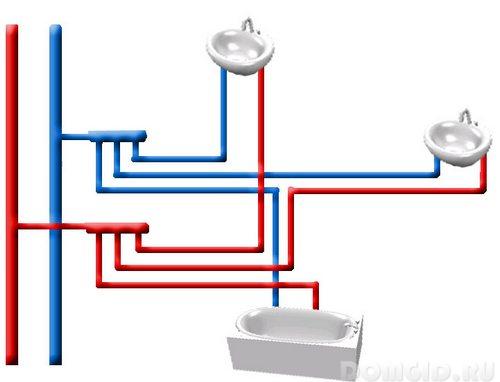
For the installation of an intra-house water system, polypropylene or metal-plastic pipes are used.
Recommendations of specialists for installation and configuration of the water supply system
Normal operation of household appliances and plumbing is possible with uninterrupted supply and sufficient water pressure. Here are some tips to help you correctly assemble and set up a water supply system:
- It is better to equip the water supply on the site in the warm season, the risk of making a mistake with the location of the aquifer is reduced, since the water level in this period is the lowest.
- If necessary, conduct the pipeline through the interior walls, walls or other building structures, the pipe must be enclosed in a plastic or metal cup.
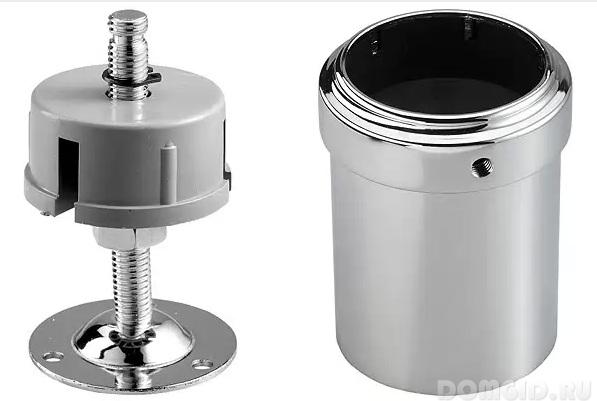
- In a water supply system with fewer angles and turns, pressure is better maintained.
- At the inlet of the collector, it is necessary to install a tap for draining water and shutoff valves.
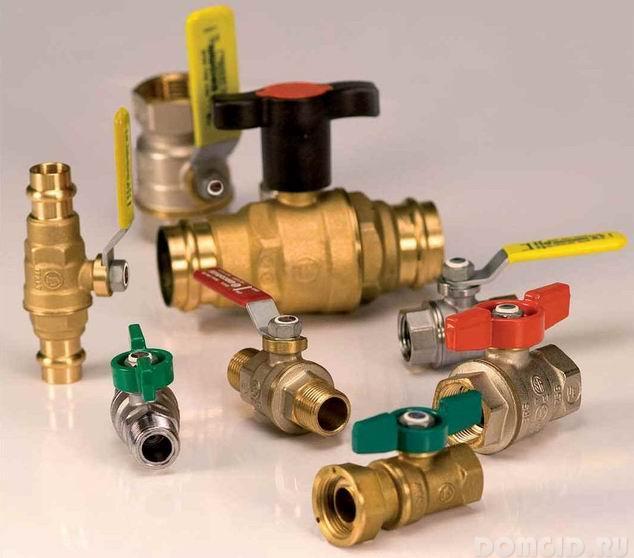
- When laying the water supply to the house, you must use the food pipe with the appropriate marking.
- The pressure in the accumulator should be 2-3 meters (0.2-0.3 Bar) less than the lower pressure threshold.
- It is advisable to choose pump models that have built-in water sensors. If there is no water, the pump turns off.
Before starting operation, the system must be checked for leaks and performance.



